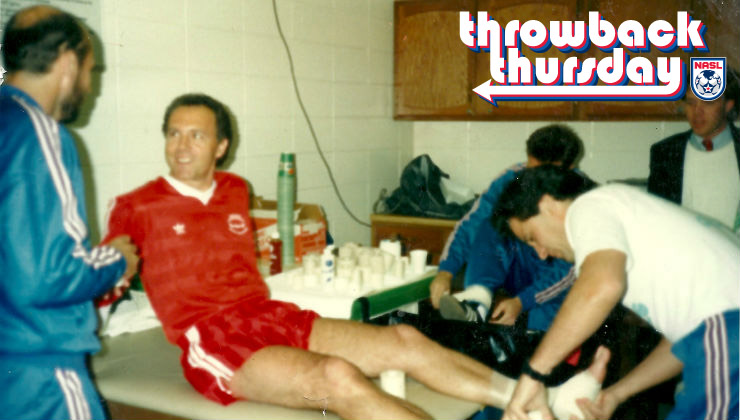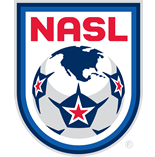THROWBACK THURSDAY | Arnold Trachtenberg: Trainer To The Stars

He sat on the Cosmos bench from 1978 to 1984 and never played a single minute of any game. During the NASL’s Golden Era, he worked with some of the world’s best players and never fielded a pass or committed a foul or scored a goal. He traveled the world (72 countries in all) with the Cosmos and was never asked for his autograph.
Arnold Trachtenberg, a guy from the Park Slope section of Brooklyn, was one of the Cosmos’ trainers as the NASL side achieved success on and off the pitch. Along the way, he had one of the best seats in the house as global superstars like Pelé, Franz Beckenbauer, Giorgio Chinaglia, and Johan Neeskens, among others, sought treatment – and as global notables like Jerry Hall, Mick Jagger, Henry Kissinger, Roger Daltrey, Steven Spielberg, and others traipsed through the locker room after games at Giants Stadium in East Rutherford, N.J.
“We were expected to win and win attractively,” Trachtenberg told NASL.com and has worked for the past six years as a physical therapist at Kessler Rehabilitation in Dumont, N.J. “We were run by a media company (Warner Communications), and it was all about entertainment. I remember we once won a game that wasn’t pretty and someone high up got upset. Giorgio said, ‘You can’t always play pretty.’ 
“With Warner many times, it was never-never land in terms of stars coming through the locker room. They were so far ahead of the curve in terms of marketing, with mascots, cheerleaders, and that stuff. I remember Franz saying then that in 20 years the game in Europe would be like this. Many Europeans looked down on the presentation, the names on the uniforms, numbers on the shorts, but Warner were geniuses in cross-marketing and most of what we did has been adopted around the world.”
In a sense, the Cosmos brought synergy to soccer long before the term became a business buzzword. They were the Galacticos long before Real Madrid’s Big Bang.
For Trachentberg, the ride with the Cosmos began shortly after finishing his collegiate studies. He attended Brooklyn College and then obtained a Master’s Degree in exercise science and physiology from Long Island University, and Trachtenberg landed a job as the trainer at his undergraduate alma mater. In the late 1970s he went with a New York State regional team to a tournament in Pennsylvania and met Ray Klivecka, a coach who was preparing an American youth team for a CONCACAF qualifying tournament for the first Youth World Cup (1977 in Tunisia, the U.S. did not qualify).
“I had played against him at Brooklyn College, and he asked me about taking the team to play in a warm climate -- like where to go train,” Trachtenberg said. “I told him Florida. We talked for hours. The next thing I know, he contacts me at Brooklyn and asks me to go with the team. We trained in Florida for two weeks, then went to Puerto Rico. Then Ray gets a job with the Cosmos as an assistant coach. He called me and said they had an opening, would I be interested? I was 29.”
Early in his Cosmos tenure, a year that included approximately 250 days on the road, the club embarked on a tour of Asia that took it to Japan, Hong Kong, South Korea, Indonesia, Malaysia, Singapore, and Australia.
“To show you how tuned in Warner was, in Indonesia one of the top singers, one who was on a Warner label, sang the national anthems. The company used people with skill and experience in media, movies, TV and music people to market the team.”
But for Trachtenberg, it was the wildly diverse collection of players from around the world that made the experience so memorable and long-lasting, even to this day
“Just being identified with that group of people, it was a special bunch that had this weird chemistry,” he said. “They were from different places and really had nothing in common other than playing the game. Hennes (Weisweiler, the team’s German coach in the early 1980s) once said that if you took a German team on a world tour like the Cosmos did they would be killing each other after a couple of days. But the Cosmos players complemented each other.
“They were all such good players and understood the importance of working together. I know it’s a cliché, but it’s true. People had different strengths. Experiences like that leave a powerful imprint -- the travel, the camaraderie, it was like a bubble.”
Dealing with some of the game’s biggest names in the game at the time, taping ankles and massaging sore muscles, left Trachtenberg with a collection of anecdotes (some unprintable) and impressions (not to mention hundreds of vintage photographs). What follows are some of his observations:
Pelé: “The nicest, most quiet man. He had the most amazing, supple muscles. After we worked with him for a while he said that if he had that type of treatment and attention in Brazil his career would have lasted longer. He said the training there was prehistoric.”
Giorgio Chinaglia: “Dedicated, conscientious, a pure goalscorer. One of the most dedicated players I’ve ever seen. He practiced hard and was the last guy off the field. Just an amazing goal scorer. I saw him play all over the world against some of the best teams in the world. And he always scored goals. He was one of a kind – a personality. Do you know why they called him Long John? Giorgio grew up in Wales, but when he went back to Italy and there was another Welsh player, John Charles, there. Charles was short and George was tall, so they called him Long John.”
Franz Beckenbauer: “When he first came to the team, he’d come to practice in a suit and tie, but after a while he became Americanized. I used to drive to work with him. He was living in [Rudolf] Nureyev’s apartment in Manhattan, and he loved it because he was anonymous. He loved the opera and loved everything about New York. When we weighed the players and he was a pound overweight he used to write it down. He was usually 166, and he weighed in at 167. He said ‘I know why, I didn’t have my coffee this morning!’ No one wanted to sit next to him at meals because he ate like a scientist.”
Johan Neeskens: “If you’d ask him to run through a wall for you and come back he would make two different holes, going and coming.”
Dennis Tueart: “A very hard working, conscientious guy. He always trained harder than anyone else. These guys knew they had limited time in their careers, especially those who grew up in professional systems. He took care of himself and knew the hard work would pay off.”
Wim Rijsbergen: “We called him the White Horse – just relentless. He used to come in after practice and put his feet in ice. His ankles were so bad. We had to tell him to get out of the ice, we were worried about frostbite.”
Hubert Birkenmeier and Andranik Eskandarian: “The odd couple – one guy from Germany, the other from Iran. They always roomed together. Eski used to like the room hot, Hubert cool. After we’d check in they’d run to the room then go out shopping.” (The inseparable twosome became known as Eskenmeier, and were even partners in a soccer/sporting goods store in Hackensack, N.J., where you can still usually find one or both of them helping youngsters pick out their soccer gear.)
Ricky Davis: “Dedicated, hardworking, he was really the first American talent. He was more of a player than Kyle Rote. He knew what strengths were, and partnered well with Bogie for years.”
Vladislav Bogicevic: “The best left foot in the world. He never got hurt, mostly because I think where most people try to stay away from defenders, his philosophy was to stay close because it made it harder for them to kick out at you. He always liked to have his back to the guy and would roll them. He never missed a game.”
Carlos Alberto: “He’d go to training, smoke a cigarette, and have coffee. He didn’t like to train much. Very cool, a big presence.”
Eddie Firmani: “A players coach. He liked to play and be more involved in the team and practice, maybe a bit too much.”
Professor Julio Mazzei: “He was a motivator. He liked to relay experiences he’d had with Brazil and Pelé. He got a lot of respect from people but didn’t know much about the game. I mean, what are you going to teach these guys anyway? They only needed a guy to make them show up on time.”
Hennes Weisweiler: “The first real tactician the Cosmos ever had. He broke down the game into little pieces, little details. He’d tell us there were nine different parts of the foot and how to use each of them when striking the ball. He was also a guy who would come into training room and tell each one of the guys that he was the most important to the game. It was all about motivation.”
The Cosmos, the NASL, and the Golden Era made for an exciting and amazing time.
“What was it like?” Trachtenberg said. “It was insane. It was a new sport. It was an exciting and amazing time. Bergen County in New Jersey was a hotbed of soccer. There was a huge groundswell of interest and support. But it was also a naive time, soccer-wise.”


